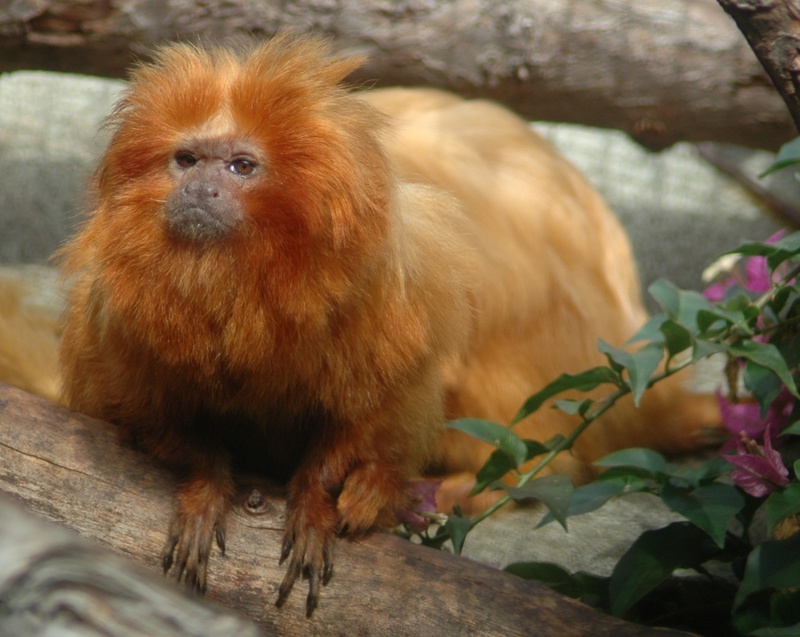|
| 질의: old world monkey | 결과: 115번째/277 | |
Golden Lion Tamarin (Leontopithecus rosalia) - Wiki
| 제목: | Golden Lion Tamarin (Leontopithecus rosalia) - Wiki
| |

| 해상도: 1512x1204
파일크기: 468599 Bytes
등록시간: 2007:01:10 22:18:39
|
Golden Lion Tamarin
From Wikipedia, the free encyclopedia
[Photo] Goldgelbes L??wen??ffchen (Leontopithecus rosalia) Source/Quelle: Fotografiert von Marcel Burkhard-->User:Cele4
The Golden Lion Tamarin (Leontopithecus rosalia), or Golden Marmoset, is a small New World monkey of the family Cebidae. Native to the humid coastal forests of Brazil, the Golden Lion Tamarin is an endangered species and among the rarest animals in the world, with an estimated wild population of 1,000 individuals and a captive population of approximately 500.
Description
As its name would suggest, this lion tamarin is a reddish orange to golden brown in colour. Its hair is longer and darker around the face, forming a mane on top of the head and on the cheeks and throat. Its limbs are slender yet capable with sharp claws, befitting its strictly arboreal life. Although quite long, its tail is not prehensile. The tail and forepaws of this monkey may have a black coloration. Its body may be up to 335 millimetres in length and its tail up to 400 mm. The Golden Lion Tamarin male reaches a maximum weight of just 700 grams in the wild though higher weights can be found in captivity. The pregnant female may weigh up to 790 grams but a non-gestating female typically weighs closer to 550 grams.
Habitat
Most of the wild population is confined to the Reserva Biol??gica de Po??o das Antas, a protected area of swampy forests in the state of Rio de Janeiro. It is an important bastion of the Golden Lion Tamarin, as only 2% of forests in the monkey's original range remains. Furthermore, its existing habitat has been broken up by logging and agriculture; this has led to isolated populations and inbreeding, a combination likely to result in extinction.
A high canopy with dense tangles of vines is required by the Golden Lion Tamarin; other than providing a home, the labyrinthine forest affords some degree of protection from its many predators. Its main predators are raptors, large cats and snakes. The canopy also provides an important source of food; the omnivorous lion tamarins rely on rainwater and insects concentrated in the reservoirs of bromeliads and other small animals inhabiting the bark of trees. Fruit is also eaten.
Behaviour and reproduction
The Golden Lion Tamarin is diurnal and primarily arboreal, forming small groups of up to fourteen individuals, led by a breeding pair; occasionally two unrelated males may be involved, but only one typically mates with the lead female. The group patrols a consistent territory of c. 400,000 square metres; fighting between groups is avoided by scent marking and "ritual encounters". By night, the tamarins sleep in abandoned nesting holes in trees, or in large bromeliads.
The group is cooperative in the rearing of young; however, only the dominant female usually breeds. The males are responsible for the bulk of rearing duties, with the mother nursing and providing transportation for the infant during its first week of life. Resources are shared among the group, as are predator surveillance duties. The young are well cared for until adolescence. Unlike other primates, both males and females leave the group; their rate of survival is low, as less than one quarter successfully integrate into a new group or establish themselves in an unoccupied territory.
Fully mature at 2-3 years, the Golden Lion Tamarin is able to breed at 18 months of age. The breeding season is from September to March. Gestation lasts for 126-130 days, usually ending in twin births; there may be up to two litters annually. The young tamarins are weaned after just 90 days; less than half of infants survive their first year of life. If they do, a lifespan of 8-15 years can be expected. One captive tamarin has been reported to be 28 years old.
In an attempt to curb the Golden Lion Tamarin's precipitous decline, several conservation programmes have been undertaken. The intent is to strengthen the wild population and maintain a secure captive population in zoos worldwide. The survival rate of re-introduced animals has been encouraging, but destruction of unprotected habitat continues.
http://en.wikipedia.org/wiki/Golden_Lion_Tamarin
| The text in this page is based on the copyrighted Wikipedia article shown in above URL. It is used under the GNU Free Documentation License. You may redistribute it, verbatim or modified, providing that you comply with the terms of the GFDL. |
|
댓글 |
|---|
| | 손님 |
|
Scientific Name: Leontopithecus rosalia (Linnaeus, 1766)
Common Names:
English – Golden Lion Tamarin, Golden Marmoset
French – Singe-lion, Tamarin Soyeux
Synonyms:
Leontopithecus aurora Elliot, 1913
Leontocebus leoninus Pocock, 1914
Leontopithecus marikina Lesson, 1840
Jacchus rosalia guyannensis Fischer, 1829
Jacchus rosalia brasiliensis Fischer, 1829 |
^o^
동물그림창고 똑똑전화 누리집
^o^
|
|
|